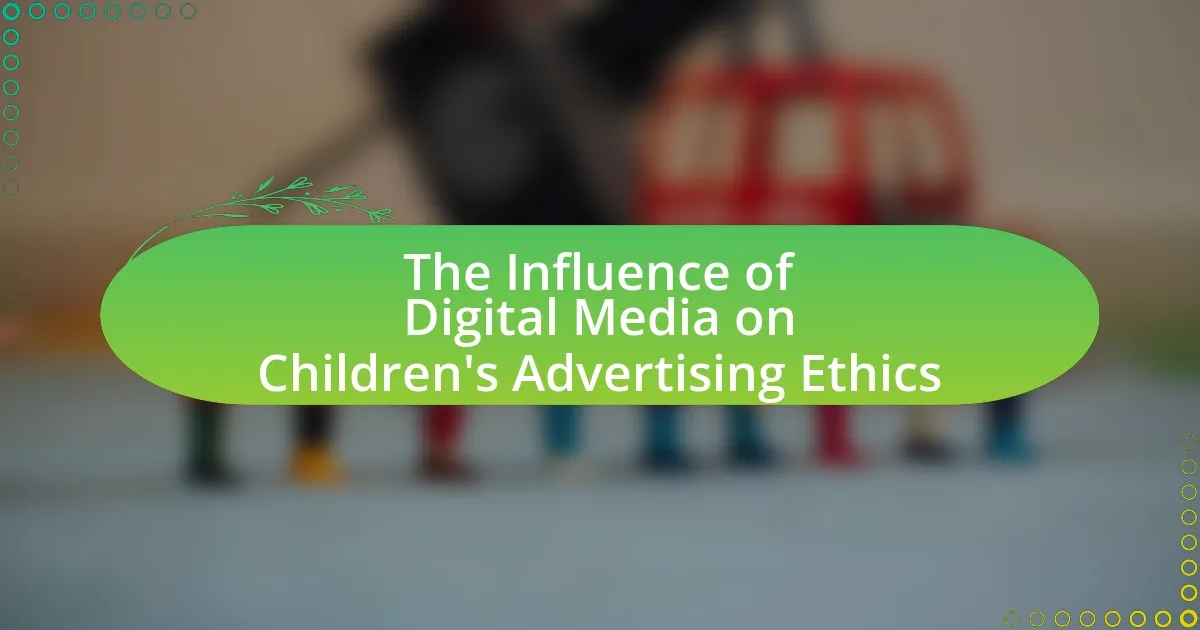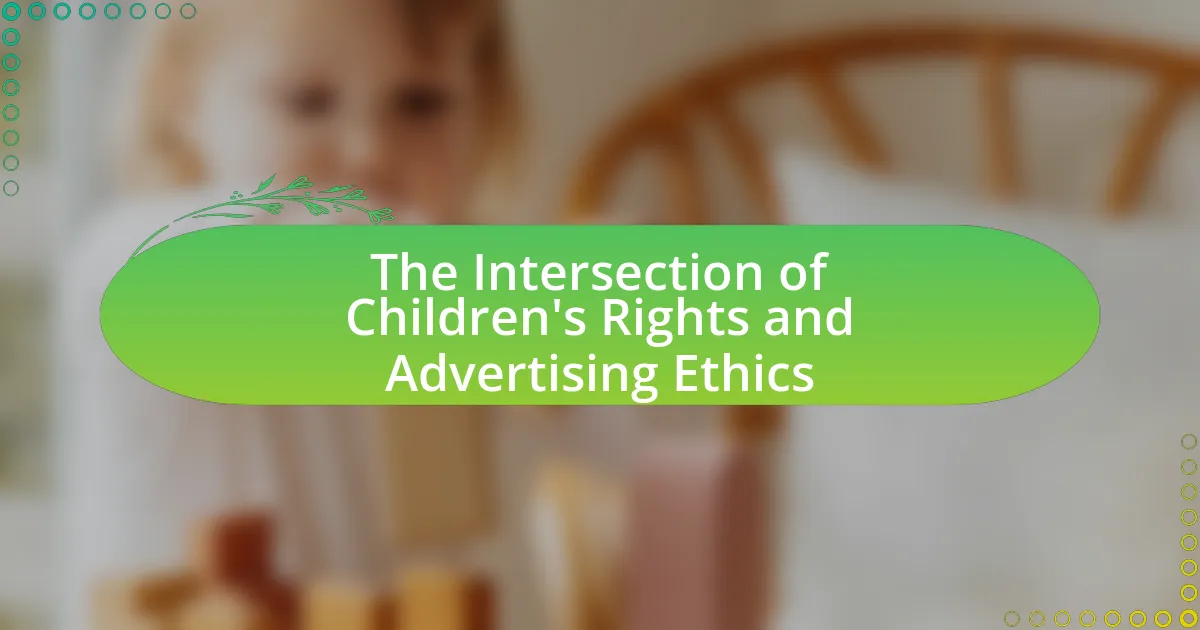The article focuses on best practices for ethical children’s advertising, emphasizing the importance of age-appropriate, truthful, and non-exploitative marketing strategies. It outlines the psychological impacts of advertising on children, highlighting the need for transparency and responsible messaging to protect their well-being. The article also discusses regulatory frameworks, the role of organizations in setting ethical standards, and strategies for incorporating cultural sensitivity and storytelling into advertising. Additionally, it addresses challenges in ethical advertising and offers solutions to ensure that marketing practices align with children’s developmental needs and promote positive values.
What are the Best Practices for Ethical Children’s Advertising?
The best practices for ethical children’s advertising include ensuring that advertisements are age-appropriate, truthful, and do not exploit children’s inexperience. Advertisers should avoid using manipulative techniques that could mislead children about the product’s benefits. For instance, the American Psychological Association emphasizes that marketing directed at children should not encourage unhealthy eating habits or promote materialism. Additionally, transparency is crucial; advertisements should clearly distinguish between content and commercial messages. Research indicates that children under eight often cannot distinguish between advertising and entertainment, highlighting the need for clear labeling. Implementing these practices helps protect children from potential harm and fosters responsible advertising.
Why is ethical advertising important for children?
Ethical advertising is important for children because it protects their developmental needs and promotes positive values. Children are impressionable and may not have the cognitive ability to critically evaluate advertising messages, making them vulnerable to manipulation. Research indicates that exposure to unethical advertising can lead to unhealthy behaviors, such as poor dietary choices and materialism. For instance, a study published in the Journal of Advertising Research found that children exposed to unhealthy food advertisements were more likely to choose those foods over healthier options. Therefore, ethical advertising ensures that marketing practices are responsible, fostering a healthier environment for children’s growth and well-being.
What psychological impacts does advertising have on children?
Advertising significantly impacts children’s psychological development by influencing their perceptions, behaviors, and emotional responses. Children are particularly susceptible to advertising messages, which can lead to increased materialism, unhealthy eating habits, and distorted body image perceptions. Research indicates that exposure to advertisements can create unrealistic expectations and desires, as children often lack the critical thinking skills to differentiate between advertising and reality. For instance, a study published in the journal “Pediatrics” found that children exposed to food advertisements were more likely to choose unhealthy snacks over healthier options, demonstrating the direct influence of advertising on their dietary choices. Additionally, the American Psychological Association has highlighted that advertising can contribute to low self-esteem and body dissatisfaction among children, particularly through the portrayal of idealized body images. These psychological impacts underscore the need for ethical considerations in children’s advertising practices.
How can ethical advertising protect children’s well-being?
Ethical advertising can protect children’s well-being by promoting age-appropriate content and avoiding manipulative tactics. This approach ensures that advertisements do not exploit children’s vulnerabilities, thereby fostering healthier consumption habits. Research indicates that ethical advertising practices, such as transparency and honesty, contribute to children’s understanding of marketing messages, which can lead to better decision-making skills. For instance, a study published in the Journal of Advertising Research found that children exposed to ethical advertising were more likely to develop critical thinking regarding advertisements, reducing the likelihood of unhealthy purchasing behaviors.
What regulations govern children’s advertising?
Regulations governing children’s advertising primarily include the Children’s Online Privacy Protection Act (COPPA) in the United States, which restricts the collection of personal information from children under 13, and the Federal Trade Commission (FTC) guidelines that prohibit deceptive advertising practices aimed at children. Additionally, the American Psychological Association (APA) emphasizes the need for ethical standards in marketing to children, advocating for transparency and the avoidance of exploitation. These regulations are designed to protect children from misleading advertisements and ensure that marketing practices are responsible and age-appropriate.
Which organizations set the standards for ethical advertising to children?
The organizations that set the standards for ethical advertising to children include the American Psychological Association (APA), the Children’s Advertising Review Unit (CARU), and the Federal Trade Commission (FTC). The APA provides guidelines that emphasize the psychological impact of advertising on children, while CARU establishes self-regulatory standards for children’s advertising to ensure that it is truthful and appropriate. The FTC enforces laws against deceptive advertising practices and has issued reports highlighting the need for ethical standards in marketing to children. These organizations collectively influence the framework for responsible advertising practices aimed at protecting young audiences.
What are the legal requirements for advertising to children?
The legal requirements for advertising to children include regulations that prohibit misleading claims, require clear identification of advertisements, and restrict the use of certain persuasive techniques. In the United States, the Federal Trade Commission (FTC) enforces the Children’s Online Privacy Protection Act (COPPA), which mandates parental consent for collecting personal information from children under 13. Additionally, the Children’s Advertising Review Unit (CARU) provides guidelines that emphasize truthfulness and appropriateness in advertising directed at children. These regulations aim to protect children from exploitation and ensure that advertisements are suitable for their age group.
How can advertisers ensure their messages are age-appropriate?
Advertisers can ensure their messages are age-appropriate by conducting thorough audience research to understand the cognitive and emotional development stages of different age groups. This involves analyzing age-specific preferences, comprehension levels, and cultural contexts to tailor content accordingly. For instance, the American Psychological Association emphasizes that children under eight often cannot distinguish between advertising and entertainment, indicating that messages for this age group should be simple, clear, and devoid of manipulative tactics. Additionally, adhering to guidelines set by organizations such as the Children’s Advertising Review Unit can help maintain ethical standards in advertising targeted at children.
What criteria should be used to evaluate age-appropriateness?
To evaluate age-appropriateness, criteria should include developmental stage, cognitive understanding, emotional maturity, and cultural context. Developmental stage assesses whether content aligns with the physical and mental capabilities of a specific age group. Cognitive understanding ensures that the material is comprehensible and relatable to the intended audience. Emotional maturity evaluates whether the content is suitable for the emotional responses of children at different ages. Cultural context considers societal norms and values that influence what is deemed appropriate for children. These criteria are essential for ensuring that advertising content is responsible and respectful of children’s needs and perceptions.
How can cultural sensitivity be incorporated into children’s advertising?
Cultural sensitivity can be incorporated into children’s advertising by ensuring that the content reflects diverse cultures accurately and respectfully. Advertisers should conduct thorough research to understand the cultural backgrounds of their target audience, which includes consulting with cultural experts and community representatives. This approach helps avoid stereotypes and misrepresentations, fostering an inclusive environment. For instance, a study by the American Psychological Association highlights that culturally relevant advertising can enhance children’s self-esteem and promote positive identity development. By integrating authentic cultural elements and narratives, advertisers can create campaigns that resonate with children from various backgrounds, ultimately leading to more effective and ethical advertising practices.
What strategies can be employed for ethical children’s advertising?
Strategies for ethical children’s advertising include using age-appropriate messaging, ensuring transparency, and promoting positive values. Age-appropriate messaging involves tailoring content to the cognitive and emotional development of children, which helps prevent manipulation. Transparency can be achieved by clearly disclosing the intent of advertisements, allowing children and parents to understand the commercial nature of the content. Promoting positive values, such as inclusivity and healthy lifestyles, aligns with ethical standards and supports children’s well-being. Research indicates that ethical advertising practices can enhance brand trust and foster long-term relationships with consumers, as seen in studies by the American Psychological Association, which emphasize the importance of responsible marketing to children.
How can storytelling enhance ethical advertising for children?
Storytelling can enhance ethical advertising for children by creating relatable narratives that promote positive values and responsible consumption. When advertisements use storytelling, they can engage children’s emotions and imagination, making the messages more memorable and impactful. For instance, research indicates that children are more likely to understand and retain ethical messages when they are presented within a story context, as it allows them to connect with characters and situations that reflect their own experiences. This approach not only fosters critical thinking about advertising but also encourages children to make informed choices, aligning with ethical advertising practices that prioritize their well-being and development.
What elements make a story engaging and appropriate for children?
Engaging and appropriate stories for children typically include relatable characters, simple language, and positive themes. Relatable characters allow children to see themselves in the story, fostering emotional connections. Simple language ensures comprehension, making the story accessible to various age groups. Positive themes, such as friendship, kindness, and problem-solving, promote moral lessons and encourage healthy emotional development. Research indicates that stories with these elements can enhance children’s cognitive and social skills, making them effective tools for learning and engagement.
How does storytelling influence children’s understanding of products?
Storytelling significantly enhances children’s understanding of products by creating relatable narratives that engage their emotions and imagination. When children hear stories about products, they can better grasp their functions, benefits, and relevance to their lives. Research indicates that narratives can improve memory retention; for instance, a study published in the journal “Child Development” found that children remember information better when it is presented in a story format compared to straightforward facts. This storytelling approach not only aids comprehension but also fosters a connection between the child and the product, making it more memorable and appealing.
What role does transparency play in children’s advertising?
Transparency in children’s advertising is crucial as it fosters trust and helps protect young audiences from misleading information. By clearly disclosing the nature of advertisements, such as identifying promotional content and avoiding deceptive practices, advertisers can ensure that children understand the difference between entertainment and marketing. Research indicates that transparent advertising practices can lead to better comprehension among children, reducing the likelihood of them being misled by persuasive techniques. For instance, a study published in the Journal of Advertising Research found that children exposed to transparent advertising were more likely to recognize it as a commercial message, thereby enhancing their ability to critically evaluate the content.
How can advertisers communicate clearly with children and parents?
Advertisers can communicate clearly with children and parents by using simple language, relatable visuals, and transparent messaging. Research indicates that children understand messages better when they are presented in a straightforward manner, avoiding complex terms and jargon. For instance, the American Psychological Association emphasizes the importance of clarity in advertising directed at children, noting that age-appropriate content enhances comprehension. Additionally, using familiar characters or themes can help engage children while ensuring that parents feel informed about the product being advertised. This approach fosters trust and understanding between advertisers, children, and parents, aligning with ethical advertising practices.
What are the benefits of being transparent in advertising practices?
Being transparent in advertising practices fosters trust between brands and consumers. This trust leads to increased customer loyalty, as consumers are more likely to engage with brands that openly share information about their products and marketing strategies. Research indicates that 94% of consumers are likely to be loyal to a brand that offers complete transparency. Furthermore, transparency can enhance brand reputation, as companies that are open about their advertising practices are often viewed as more ethical and responsible. This positive perception can result in higher sales and improved market share, as consumers prefer to support brands that align with their values.
How can collaboration with parents and educators improve advertising ethics?
Collaboration with parents and educators can significantly improve advertising ethics by fostering a shared understanding of children’s developmental needs and ethical standards. When parents and educators work together, they can provide insights into the impact of advertising on children, ensuring that marketing strategies prioritize children’s well-being. Research indicates that parental involvement in media literacy programs enhances children’s critical thinking skills regarding advertisements, leading to more ethical advertising practices. For instance, studies show that children exposed to media literacy education are better equipped to discern persuasive intent in advertising, which can lead to more responsible advertising content.
What methods can be used to involve parents in the advertising process?
To involve parents in the advertising process, companies can utilize methods such as collaborative content creation, feedback surveys, and educational workshops. Collaborative content creation allows parents to contribute ideas and insights, ensuring that advertisements resonate with family values. Feedback surveys enable parents to express their opinions on advertising campaigns, fostering a sense of involvement and trust. Educational workshops can inform parents about advertising strategies and ethical practices, empowering them to engage actively in discussions about children’s media consumption. These methods not only enhance parental involvement but also align with ethical advertising standards by prioritizing transparency and family engagement.
How can educators provide insights into children’s needs and perceptions?
Educators can provide insights into children’s needs and perceptions by employing observational techniques, conducting surveys, and facilitating discussions. Observational techniques allow educators to witness children’s interactions and behaviors in various settings, revealing their preferences and emotional responses. Surveys can be designed to gather direct feedback from children about their interests and feelings, providing quantitative data that reflects their needs. Additionally, discussions in a safe and open environment encourage children to express their thoughts and opinions, offering qualitative insights into their perceptions. Research indicates that these methods can effectively capture children’s voices, as highlighted in studies like “Listening to Children: A Review of Research on Children’s Perspectives” by the National Children’s Bureau, which emphasizes the importance of understanding children’s views for effective educational practices.
What are the challenges and solutions in ethical children’s advertising?
The challenges in ethical children’s advertising include the vulnerability of children to manipulation, the difficulty in ensuring truthful messaging, and the potential for promoting unhealthy behaviors. Children are impressionable and may not fully understand the persuasive intent behind advertisements, leading to exploitation. Additionally, regulatory frameworks often lag behind the rapid evolution of digital advertising, making it challenging to enforce ethical standards.
Solutions to these challenges involve implementing strict guidelines that prioritize transparency and age-appropriate content, as well as fostering media literacy among children. For instance, organizations like the American Psychological Association advocate for policies that limit advertising to children under the age of eight, recognizing their inability to critically evaluate marketing messages. Furthermore, brands can adopt self-regulatory measures, such as adhering to the Children’s Advertising Review Unit guidelines, which promote responsible advertising practices. These approaches help create a safer advertising environment for children while encouraging ethical standards in the industry.
What common pitfalls do advertisers face in ethical children’s advertising?
Advertisers face several common pitfalls in ethical children’s advertising, primarily including misleading messaging, exploitation of children’s naivety, and failure to adhere to regulatory guidelines. Misleading messaging occurs when advertisements exaggerate product benefits, leading children to form unrealistic expectations. Exploitation of children’s naivety happens when advertisers target young audiences who may not fully understand persuasive intent, making them vulnerable to manipulation. Additionally, failure to adhere to regulatory guidelines, such as those set by the Federal Trade Commission, can result in legal repercussions and damage to brand reputation. These pitfalls highlight the importance of transparency and responsibility in advertising directed at children.
How can misleading messages be avoided in children’s advertising?
Misleading messages in children’s advertising can be avoided by implementing strict guidelines that ensure clarity and honesty in marketing communications. Regulatory bodies, such as the Federal Trade Commission (FTC) in the United States, provide frameworks that require advertisements to be truthful and not deceptive, particularly when targeting children. For instance, the Children’s Advertising Review Unit (CARU) enforces self-regulatory guidelines that mandate clear disclosures about the nature of products and their benefits, ensuring that claims are substantiated. Research indicates that children are particularly vulnerable to misleading information, making it essential for advertisers to use age-appropriate language and visuals that accurately represent the product. By adhering to these regulations and best practices, advertisers can significantly reduce the risk of misleading messages in their campaigns aimed at children.
What are the consequences of unethical advertising practices?
Unethical advertising practices can lead to significant consequences, including legal repercussions, loss of consumer trust, and damage to brand reputation. For instance, companies that engage in false advertising may face lawsuits and fines from regulatory bodies, as seen in cases like the Federal Trade Commission’s actions against misleading claims. Additionally, consumers are likely to lose trust in brands that employ unethical tactics, which can result in decreased sales and customer loyalty. Research indicates that 86% of consumers are more likely to trust brands that demonstrate ethical behavior, highlighting the importance of integrity in advertising. Ultimately, unethical advertising not only harms consumers but also jeopardizes the long-term success of businesses.
How can technology be leveraged for ethical advertising?
Technology can be leveraged for ethical advertising by utilizing data analytics and targeted marketing to ensure that advertisements are relevant and appropriate for children. By employing algorithms that analyze user behavior and preferences, advertisers can create tailored content that resonates with young audiences while adhering to ethical standards. For instance, the Children’s Online Privacy Protection Act (COPPA) mandates that advertisers must obtain parental consent before collecting personal information from children, which technology can facilitate through secure data management systems. Additionally, platforms like Google and Facebook provide tools that allow advertisers to filter content based on age-appropriateness, ensuring that children are not exposed to misleading or harmful advertisements. This approach not only enhances the effectiveness of advertising but also promotes a responsible advertising environment that prioritizes the well-being of children.
What digital tools can help create responsible advertising content?
Digital tools that can help create responsible advertising content include content management systems, social media analytics platforms, and compliance software. Content management systems like WordPress enable advertisers to create and manage content while ensuring adherence to ethical guidelines. Social media analytics platforms, such as Hootsuite, allow for monitoring audience engagement and sentiment, ensuring that advertising strategies align with responsible messaging. Compliance software, like AdWatch, helps ensure that advertisements meet legal and ethical standards, particularly important in children’s advertising, where regulations are stringent. These tools collectively support the creation of advertising content that is not only effective but also responsible and ethical.
How can data privacy be maintained while targeting children?
Data privacy can be maintained while targeting children by implementing strict data protection measures and adhering to legal regulations such as the Children’s Online Privacy Protection Act (COPPA). These measures include obtaining verifiable parental consent before collecting personal information, limiting data collection to what is necessary for the intended purpose, and ensuring that any data collected is securely stored and not shared with third parties without explicit consent. Additionally, companies should provide clear privacy policies that are easily understandable for both children and their parents, outlining how data will be used and the rights of the users. Following these practices not only complies with legal requirements but also fosters trust with families, ensuring that children’s data privacy is respected.
What are the best practices for creating ethical children’s advertisements?
The best practices for creating ethical children’s advertisements include ensuring that content is age-appropriate, truthful, and promotes positive values. Advertisers should avoid exploiting children’s naivety by using clear and honest messaging that does not mislead them about the product’s benefits. Additionally, advertisements should respect children’s privacy and not collect personal information without parental consent. Research indicates that ethical advertising can foster trust and long-term brand loyalty among young consumers, as seen in studies by the American Psychological Association, which emphasize the importance of responsible marketing practices.
How can advertisers develop a code of ethics for their campaigns?
Advertisers can develop a code of ethics for their campaigns by establishing clear guidelines that prioritize honesty, transparency, and respect for the target audience. This involves conducting thorough research on ethical standards relevant to advertising, particularly those that protect vulnerable groups such as children. For instance, the American Psychological Association emphasizes the importance of avoiding manipulative tactics that exploit children’s naivety. Additionally, advertisers should engage stakeholders, including parents and educators, to gain insights into ethical concerns and expectations. By incorporating feedback from these groups, advertisers can create a code that reflects societal values and promotes responsible advertising practices.
What steps can be taken to evaluate the effectiveness of ethical advertising?
To evaluate the effectiveness of ethical advertising, one can implement several key steps. First, establish clear metrics for success, such as brand awareness, consumer trust, and engagement levels, which can be measured through surveys and analytics. Second, conduct pre- and post-campaign assessments to gauge changes in consumer perceptions and behaviors, utilizing tools like focus groups and A/B testing. Third, analyze compliance with ethical standards by reviewing the content for honesty, transparency, and respect for the target audience, particularly in children’s advertising, where regulations are stringent. Lastly, gather feedback from stakeholders, including parents and educators, to ensure that the advertising resonates positively and aligns with ethical guidelines. These steps collectively provide a comprehensive framework for assessing the impact and integrity of ethical advertising initiatives.






